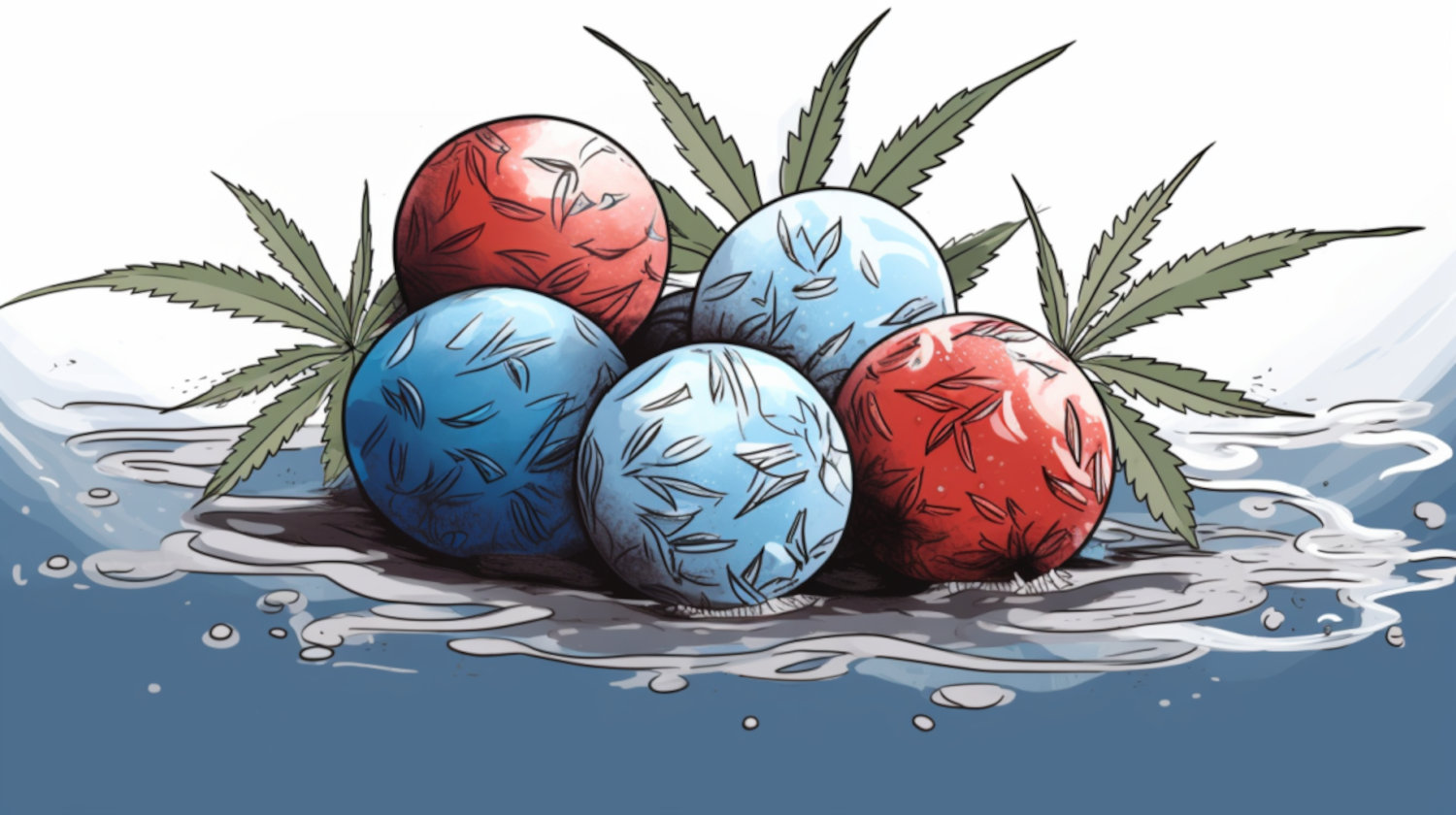In This Article
- What are THC Bath Bombs?
- How Do THC Bath Bombs Work?
- What are the Benefits of THC Bath Bombs?
- Are There Any Risks of THC Bath Bombs?
- How to Make Your Own THC Bath Bombs
- THC Bath Bomb FAQ
- Are THC bath salts the same as bath bombs?
- Are there delta-8 bath bombs?
- Do CBD bath bombs work?
- What are some top THC bath bomb brands?
- References
The world of cannabis continues to evolve. Once largely limited to smoking and the occasional edible, cannabis products now include a myriad of uses and applications. Among the innovations are topicals, a largely non-intoxicating application method that rarely ever reaches the bloodstream, benefiting the skin, muscles, and joints.
Some of the more intriguing topicals created in recent years have been CBD and THC bath bombs and salts. Infusing THC into a classic bath bomb or salt allows a person to enjoy the benefits of cannabis as well as the fragrant extracts and oils found in traditional relaxation products.
You can buy a weed bath bomb at many shops and online stores. But what about making your own?
What are THC Bath Bombs?
A THC-based bath bomb is just like any other bath bomb, other than it includes the healing benefits of cannabis as a prominent ingredient.
Bath bombs blend wet and dry ingredients, including moisturizing agents, baking soda, essential oils, scents, bubbles, and colors, to create a soothing, aromatic, and visually appealing bath. The ingredients are often shaped into balls or other shapes that begin to fizz and dissolve when introduced to water, releasing the bomb's elements into the water.
How Do THC Bath Bombs Work?

It's all made possible by introducing the bomb to your bathwater. Once a bath bomb touches water, it fizzes, dissolves, and releases its contents.
A CBD or THC bath bomb acts like most other topicals, save for one crucial difference. With cannabis included, consumers are likely to experience many additional benefits as the plant's cannabinoids are consumed via the body's mucous membranes.1 Most cannabis topicals won't go through the skin to reach the bloodstream, meaning you won't feel the effects of any cannabinoids beyond localized bodily relief.2
However, some topicals, like transdermals, can reach the bloodstream, providing the potential for getting high or feeling the effects of cannabinoids throughout the body.3 Bath bombs, unlike your standard topical lotions, can also be absorbed through the mucous membranes in the vaginal and rectal cavities during a bath. This can sometimes create a euphoric effect, which may or may not be intoxicating for some. If this concerns you, pay particular attention to the product information and ingredients before buying.
What are the Benefits of THC Bath Bombs?
Reported benefits of bath bombs and other topicals include:
- Treatment of musculoskeletal conditions
- Mind and body relaxation
- Pain relief
- Treatment of skin diseases and disorders
While benefits are often reported anecdotally, additional research is required to verify many claims.
Introducing THC into a bath bomb elevates the experience that much more. Not only do you get to experience the familiar soothing and aromatic pleasures of a bath bomb. But with THC included, you likely will experience the benefits of a THC or CBD topical, which may consist of:4
- Anti-inflammatory
- Anti-itching
- Analgesics
- Wound healing
- Anti-proliferative effects on the skin
Are There Any Risks of THC Bath Bombs?

Using a THC bath bomb typically carries little to no elevated risk from what you'd encounter with any bath bomb or topical. Bath bombs are not known to cause excessive intoxication or side effects like anxiety. Still, they can result in muscle relaxation, so take caution when standing up after using a THC bath bomb, especially if you have mobility issues or are elderly.
In most cases, consumers likely will only need to concern themselves with the contents of the bath bomb. Avoid using products containing ingredients you are allergic to or have a history of developing adverse reactions. Despite cannabis topicals rarely being formulated to reach the bloodstream, those with a rare cannabis allergy should consider avoiding the plant, even on a skin level. Or, at least hold off using such a topical until you consult with a trusted medical professional.
How to Make Your Own THC Bath Bombs
Making your own weed-based bath bomb at home is relatively easy and fun. Your formulation may differ due to your preference and skin needs. Still, most bath bombs will use the following ingredients:
- Baking soda (4 oz)
- Corn starch (2 oz)
- Citric acid (2 oz)
- Epsom salt (2 oz)
- Water (1.5 teaspoons)
- Essential oils of your choice (1 teaspoon)
- THC or CBD oil or tincture (.25 tablespoons)
- Food coloring or color powder
You can increase the dosage of cannabis by using more THC or CBD in oil or tincture form. Remember to adjust your dose and amount of ingredients depending on the number of bath bombs you plan to make. You'll also want to have on hand:
- Bath bomb molds
- Mixing bowl
- Small glass or measuring cup
- Whisk
- Spoon or small stirrer
- Paper towels or rags to clean any mess
Once you have everything in order, it's time to make your weed-infused bath bombs:
- Combine all dry ingredients (except for color) in a mixing bowl, whisking for an even mixture.
- Combine your wet ingredients (except color) in a separate glass.
- Slowly introduce the wet ingredients into the mixing bowl, whisking to avoid premature fizzing or dissolving. Add 1 to 2 drops of color when ready.
- Mix until the ingredients are damp and able to hold together. Add additional water if the mixture isn't keeping as desired.
- Fill your molds with the ingredients. Overfill each mold just a bit without packing too densely.
- Press the halves of your molds together, then remove one side. Allow both sides to sit for 20 minutes. Then, extract the other half of the bomb from the mold.
- Allow the bombs to sit for several hours to dry.
- Store and use at your leisure.
THC Bath Bomb FAQ

Are THC bath salts the same as bath bombs?
THC bath bombs and THC bath salts are similar but have their differences. Unlike a bath bomb, salts are loose and granular. When introduced to water, they dissolve rather than fizz. Both products contain similar ingredients focused on skincare and relief. However, bath bombs create more of a robust experience by incorporating fun shapes and colors, along with cannabis in their formulation.
Are there delta-8 bath bombs?
Yes. Some brands have created bath bombs using cannabinoids like delta-8. However, with the lack of regulation and oversight of companies producing these products, it is best to stick with products sold from licensed dispensaries in your state or opt for CBD bath bombs with verifiable COAs proving the product is free of contaminants.
Do CBD bath bombs work?
Yes, CBD bath bombs operate just like the THC variety. The only significant difference is that CBD bath bombs would affect things like the muscles and joints while producing little to no noticeable euphoric effects and, unless used in high doses, excessive muscle relaxation.
What are some top THC bath bomb brands?
The choice is subjective, based on your preferences and needs. Using sales data and feedback, Kush Queen, OM, and High Desert Pure are a few brands you may want to try first. But the choice is ultimately up to you.
References
- Filipiuc S-I, Neagu A-N, Uritu CM, Tamba B-I, Filipiuc L-E, Tudorancea IM, Boca AN, Hâncu MF, Porumb V, Bild W. The Skin and Natural Cannabinoids–Topical and Transdermal Applications. Pharmaceuticals. 2023; 16(7):1049. https://doi.org/10.3390/ph16071049 ↩︎
- Hess C, Krämer M, Madea B. Topical application of THC containing products is not able to cause positive cannabinoid finding in blood or urine. Forensic Sci Int. 2017;272:68-71. doi:10.1016/j.forsciint.2017.01.008 ↩︎
- Mahmoudinoodezh H, Telukutla SR, Bhangu SK, Bachari A, Cavalieri F, Mantri N. The Transdermal Delivery of Therapeutic Cannabinoids. Pharmaceutics. 2022;14(2):438. Published 2022 Feb 18. doi:10.3390/pharmaceutics14020438 ↩︎
- Makhakhe L. Topical cannabidiol (CBD) in skin pathology - A comprehensive review and prospects for new therapeutic opportunities. S Afr Fam Pract (2004). 2022;64(1):e1-e4. Published 2022 May 30. doi:10.4102/safp.v64i1.5493 ↩︎
The information in this article and any included images or charts are for educational purposes only. This information is neither a substitute for, nor does it replace, professional legal advice or medical advice, diagnosis, or treatment. If you have any concerns or questions about laws, regulations, or your health, you should always consult with an attorney, physician or other licensed professional.




